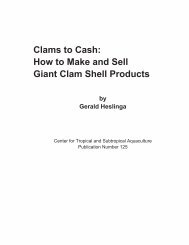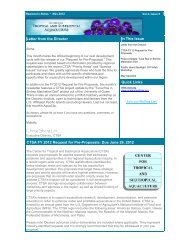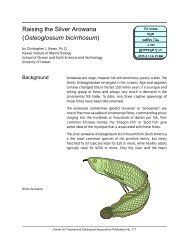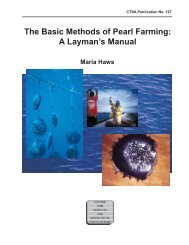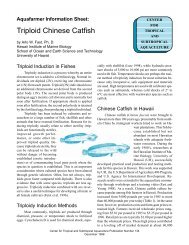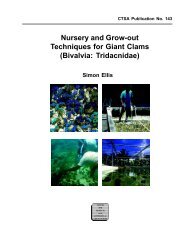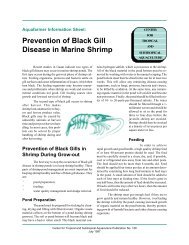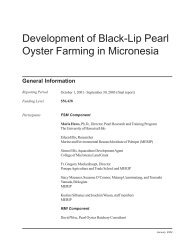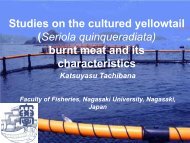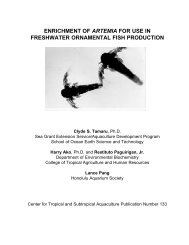Producing Pearls Using the Black-lip Pearl Oyster - CTSA
Producing Pearls Using the Black-lip Pearl Oyster - CTSA
Producing Pearls Using the Black-lip Pearl Oyster - CTSA
You also want an ePaper? Increase the reach of your titles
YUMPU automatically turns print PDFs into web optimized ePapers that Google loves.
<strong>Producing</strong> <strong><strong>Pearl</strong>s</strong> <strong>Using</strong> <strong>the</strong> <strong>Black</strong>-<strong>lip</strong> <strong>Pearl</strong> <strong>Oyster</strong> (Pinctada margaritifera)Page 8Larval, larvae: an early developmental stage of <strong>the</strong> pearl oysterlife cycle when <strong>the</strong> pearl oyster is a microscopic andfree-swimming organism. This period last 2-3 weeks.Mabe or half pearl: dome-shaped secretions of nacre developedover an artificial form that is attached to <strong>the</strong> shell.Mantle: part of <strong>the</strong> tissue of <strong>the</strong> oyster that lays down <strong>the</strong>nacre.Metamorphosis: developmental stage involving anatomicaland behavioral changes that transform <strong>the</strong> free-swimminglarvae to a settled adult.Nacre or mo<strong>the</strong>r-of-pearl: The iridescent material lining <strong>the</strong>inside of mollusk shells. Nacre is composed of calciumcarbonate crystals (aragonite) deposited between layersof organic material. Nacre is one of <strong>the</strong> types of shellmaterial formed by <strong>the</strong> epi<strong>the</strong>lial cells in <strong>the</strong> mantle tissue.Nucleus: a small, polished bead made from <strong>the</strong> shell of freshwatermussels used as <strong>the</strong> core of cultured pearls.<strong>Pearl</strong> sack: <strong>the</strong> tissue containing <strong>the</strong> nacre-producing epi<strong>the</strong>lialcells which enclosed <strong>the</strong> developing pearl. Thepearl sac develops out of <strong>the</strong> transplanted piece of mantletissue (<strong>the</strong> graft) that is inserted into <strong>the</strong> gonad duringgrafting. This term may also be used to refer to <strong>the</strong> extremeend of <strong>the</strong> gonad where <strong>the</strong> nucleus is inserted.Spat: juvenile pearl oysterSpawn, spawning: release of eggs or sperm by <strong>the</strong> pearl oysterinto <strong>the</strong> water.AcknowledgmentsThis publication was prepared as part of <strong>the</strong> work undera project titled “Aquaculture Extension and Training Supportin <strong>the</strong> U. S. Affiliated Pacific Islands - Year 10.” Fundingwas partially provided by <strong>the</strong> Center for Tropical andSubtropical Aquaculture through a grant from <strong>the</strong> CooperativeState Research Service of <strong>the</strong> U.S. Department of Agriculture(grant #97-38500-4042). This publication is alsofunded in part by a grant from <strong>the</strong> Pacific Aquaculture DevelopmentProgram which is sponsored by <strong>the</strong> U.S. Departmentof <strong>the</strong> Interior, Office of Insular Affairs (grant #GEN103), and in part by a grant/cooperative agreement from <strong>the</strong>National Oceanic and Atmospheric Administration, project#A/AS-1, which is administered by <strong>the</strong> University of HawaiiSea Grant College Program, SOEST, under InstitutionalGrant No. NA86RG0041 from NOAA Office of Sea Grant,Department of Commerce. The views expressed herein arethose of <strong>the</strong> authors and do not necessarily reflect <strong>the</strong> viewsof <strong>the</strong> U.S. Department of Agriculture, U.S. Department of<strong>the</strong> Interior, <strong>the</strong> Center for Tropical and Subtropical Aquaculture,<strong>the</strong> Pacific Aquaculture Development Program or anystaff of those agencies. UNIHI-SEAGRANT-TR-98-07.Center for Tropical and Subtropical Aquaculture Publication Number 141December 1999



